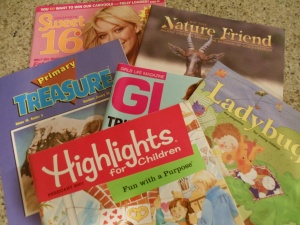Sometimes I get a niggling, squirmy idea that’s “too” something–too much for a picture book, too little for a novel, but it’s perfect for a children’s magazine article. Magazines–remember those? With so much focus on writing book-length manuscripts, it’s easy to gloss over magazines as a great option for your “too” topics (e.g., giant centipedes, yaks in Tibet, Burmese pythons, sculpting, pillow-making, door-decorating–yes, I’ve sold articles about all of those and more).
For the uninitiated, let me take a swing at answering some common questions . . .
What are the benefits of writing for children’s magazines?
Gaining publishing credits. Wouldn’t you love a title or two (or six) to tack onto your next query letter?
Learning to work with an editor. Without exception, all of the magazine editors I’ve encountered are warm, hardworking professionals who care about craft and not simply compiling enough “stuff” to stuff the next issue. There’s real value in building that relationship.
Seeing your name in print. Now, that’s sexy.
And here’s one you might not expect–you can incorporate tidbits from your research for a non-fiction article to bring authenticity and depth to a novel or picture book. When a character in my first novel needed to do a report for school, I had him do it on the giant centipede. I already had lots of info and it suited his character beautifully (even though centipedes are so creepy!) In my second novel, my main character meets an artist who teaches him how to sculpt–much of what I know about sculpting came from a non-fiction article I wrote for Highlights, which involved interviewing a sculptor.
How do you know what magazines want and how to submit to them?
The research process is very similar to determining which publishing house you’d like to approach with your book. Magazines include submission guidelines on their web sites and by perusing the magazine itself (either online, on the newsstand, in the library or by asking for a sample), you’ll get a good idea of the types of content the magazine would welcome. As with book publishers, be sure to follow submission guidelines exactly.
Is it easier to break into the magazine market compared to books?
Well, yes, relatively speaking. Just think about it number-wise. A small imprint may publish two or three books a year. Larger houses can do far more, but they also get an exponentially higher volume of submissions. This results in stiffer competition for every available spot. Now, consider a monthly children’s magazine. Imagine the metric ton of content the editor needs–articles, stories, puzzles, crafts, recipes, jokes and games–for a single issue. I’ve been a magazine editor in the past, for two different publications, and I remember how much pressure it was to create each issue, given the amount of excellent content needed. The greater the need, the better your chances of being able to sell your work.
What if I have professional quality photos to go with my article, can I send those?
Photos can be a selling point with a non-fiction article. Let the editor know photos are available upon request. For that Highlights article I mentioned earlier, I had photos of the artist and his work, which not only enhanced the article, but my payment as well.
Can I actually make money writing for magazines?
You’d have to be extraordinarily motivated to make a steady income via magazine submission sales. The real prize, from my perspective anyway, is in the publishing credit and the experience. Payments vary widely depending on the magazine’s circulation, the type of article and its word count, and any “extras” you’re able to provide, such as photographs. Once your submission has been accepted, you’ll receive a contract which will spell out your rights and the rate you can expect. One hint–if you have a choice, opt for a magazine that pays upon acceptance versus payment upon publication.
Isn’t writing for magazines going to take away from my “real” writing?
Never, ever, ever make the mistake of thinking, it’s “just” a magazine article. It is real writing. Always send your most sparkling work. If needed, do thorough research and document your sources carefully. Your professionalism is a reflection of your ability, true, but your best writing also honors your reader who deserves your finest. Also, keep in mind, it’s not uncommon for magazine articles to be re-printed at some point. So, avoid viewing articles as “throw away” pieces that are only around a month or two. And thanks to the Internet, they can live indefinitely.
If you have other magazine-writing related questions, send me a message via my Contact Page. I’ll be glad to help if I can.
So, that’s what I do with my “too” ideas. I enjoy doing it, and I bet you will too.
In a magazine, one can get – from cover to cover – 15 to 20 different ideas about life and how to live it. ~ Maya Angelou



